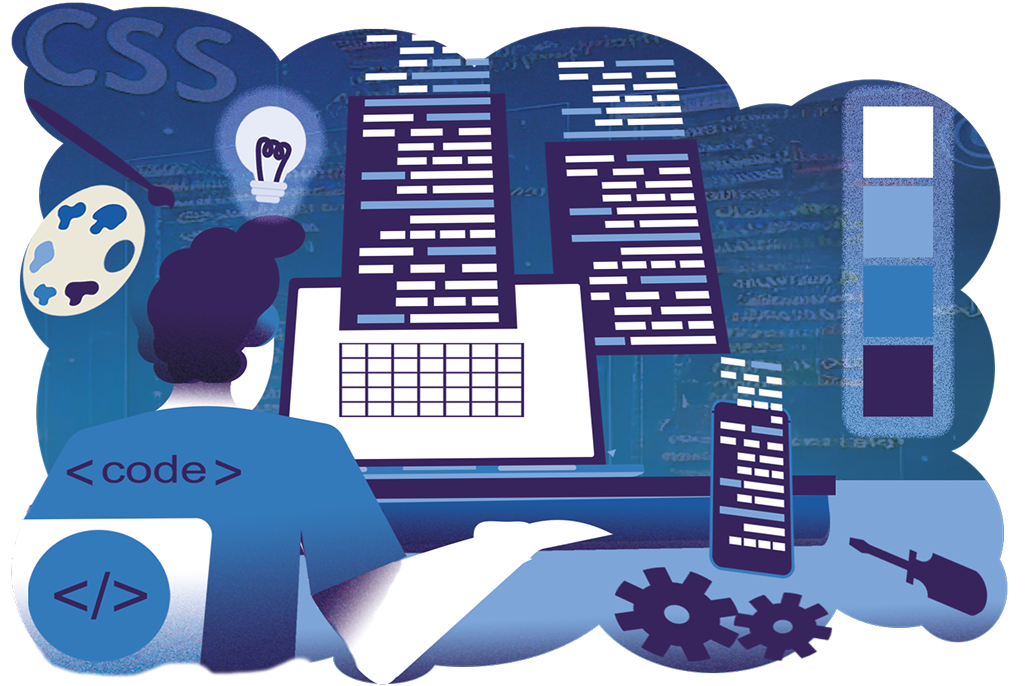
Vision
The Value of Being Yourself: Personal Branding and Monetization Strategies
Radio and TV host, Francesca Leto has built her personal brand. Find out how in the following lines.
Vision
Why be influenced by related professions? The boundaries between front-end development and web design are becoming increasingly blurred, giving rise to shared tools and languages.

Between web designers and web developers, there is a dichotomy that seems to separate two distinct worlds, often accused of not understanding each other. On one side, designers with their aesthetic and creative vision; on the other, front-end developers immersed in programming languages—a dense cascade of symbols reminiscent of the Matrix sequences—with the only difference being that no red pill will help to decode them.
The preconception is simple: it is difficult to appreciate what you do not understand. If a designer is unfamiliar with code, or a developer does not recognize the value of a well-crafted user experience, the final product is likely to suffer.
So, should a good designer know how to code? And can a developer disregard aesthetics?
Not long ago, web designers and developers operated on parallel tracks, observing each other from a distance and only crossing paths occasionally. Designers would create static interfaces in Photoshop, while developers were responsible for translating those ideas into code—a process that involved minimal communication. This clear-cut division was fertile ground for misunderstandings and compromises: graphical details lost in translation, complex functionalities simplified out of necessity, and a game of telephone between those imagining the user experience and those bringing it to life.
The growing complexity of the web has made communication between these two roles indispensable, requiring iterative workflows and constant collaboration. It is no longer a matter of handing off a project like a relay race but of building a shared language based on reusable components and living documentation.
Today, as in the past, the objective remains the same. The new challenge is to establish a constructive dialogue and a collaborative working method throughout all design and development phases, identifying and solving inefficiencies together.
It is said that different backgrounds and approaches lead to different problems; however, when design tools align with development logic, the gap between visual design and technical implementation narrows, reducing issues caused by these differences. This hybridization extends beyond web design tools to the entire front-end ecosystem, where the fusion of form and function becomes increasingly organic.
The result? A blurred boundary between the two roles, a converging language, and shared approaches—with designers thinking in terms of components and developers immersing themselves in user experience (UX).
If not the most beloved, Figma is certainly one of the most recognized tools in web design. It facilitates a smooth and collaborative design process, offering features like interactive prototyping, variable management, and CSS code export. These capabilities make it a true bridge between design and development.
An interesting aspect of Figma—being a web design tool—is how it aligns with concepts familiar to developers. When a web designer uses Auto Layout, they are, consciously or not, adopting a developer-like mindset. After all, Auto Layout is essentially a fancier version of a CSS flex display: sections and dynamic components resize and adapt to the content or the device, just like Flexbox does in coded interfaces.
Design tokens define and document design decisions. Simply put, they are variables—a standardized way to describe colors, typography, spacing, borders, shadows, and any other recurring property. What was once the domain of coding is now part of the design workflow.
Just as in programming languages, these tokens can be created and managed through Figma’s local variables panel. Exported as JSON (JavaScript Object Notation) files—a data format that represents information structures—these tokens facilitate integration with development systems. A specific Figma plugin further streamlines the process by analyzing local variables and generating JSON files compatible with Tailwind CSS, one of the most common utility-first CSS frameworks.
In short, adopting design tokens and using shared formats enable collaborative work, where tools and language become key points of connection.
On the other side, recent years have seen the rise and cross-pollination of development frameworks, keeping pace with web innovations. Concepts like responsive design, mobile-first, and design systems have become part of web developers’ daily vocabulary, transforming into guiding principles for creating consistent and adaptable digital experiences.
When it comes to CSS frameworks, Bootstrap remains the undisputed leader. With its iconic 12-column grid system, it has made responsive layouts more accessible, allowing designs to adapt seamlessly across devices. Its revolutionary mobile-first approach encourages developers to prioritize the smartphone version of a website.
An emblem of design systems is MUI (Material-UI). Based on Google’s Material Design, it is now one of the most widely used libraries for building interfaces in React. With its pre-built components, it helps create dynamic, fluid, and intuitive interfaces, further aligning the work of web designers and developers to deliver a smooth digital experience.
Returning to the initial question: Is it truly necessary for a web designer to know how to code, and for a developer to think aesthetically?
Becoming an expert in everything is not mandatory, and we cannot predict whether hybrid professional roles will define the future. However, one thing is certain: interdisciplinary collaboration is inevitable.
The real difference lies in each individual’s approach—embracing influences from other fields and, above all, cultivating curiosity opens up new perspectives. Understanding the work of complementary professionals not only enriches one’s point of view but also makes for better collaborators and more well-rounded professionals.
And who knows—maybe it will lead to unexpected passions and unpredictable new paths.